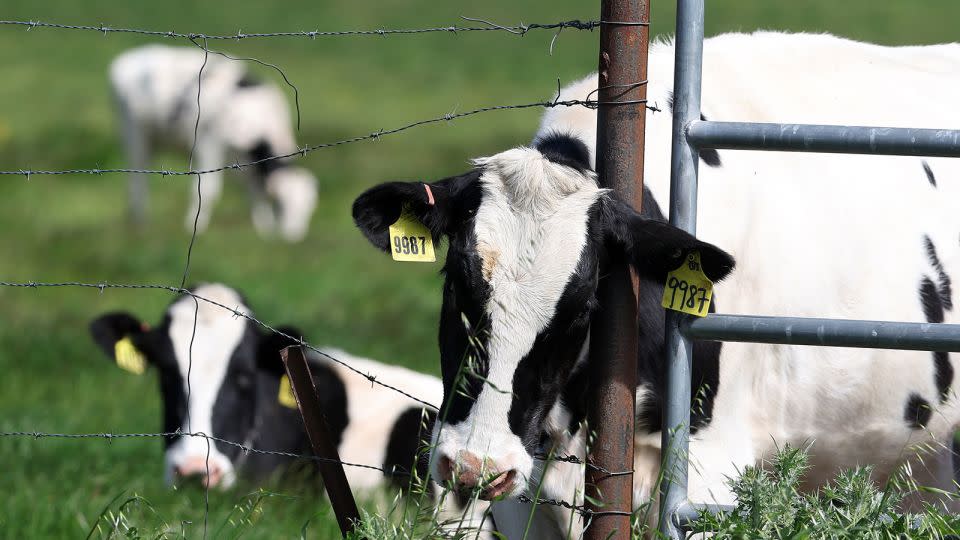The cow’s amazing ability to sustain itself by eating nothing but grass is one of the marvels of nature, but it comes at a cost.
As grass ferments in the rumen — one of four compartments in the animal’s stomach — it naturally produces methane, a greenhouse gas 28 times more potent than CO2, although shorter lived in the atmosphere. That methane is released through belching and farting, and on average, a single cow can produce about 200 pounds of it per year. The gas is also released by manure, and livestock accounts for about a third of human-related methane emissions, which are collectively responsible for about 30% of global warming.
Some farms that feed cows in yards already use food additives that help reduce methane production in a cow’s stomach, but they have downsides, such as variable efficacy and the need to be constantly supplied, which is difficult if the animals are free to roam.
A vaccine could be an alternative, and the Pirbright Institute in the UK, a virology lab focusing on livestock, is leading a three-year study to develop one. “The appeal of a vaccine as part of the solution is that it’s a very well adopted, common practice, with infrastructure able to do this already, and people know about the benefits of vaccination for animal health generally,” says John Hammond, director of research at The Pirbright Institute.
Beef has the highest amount of associated greenhouse gas emissions among major food products. - Justin Sullivan/Getty Images/File
The international effort is supported by $9.4 million from the Bezos Earth Fund, the Amazon founder’s philanthropic entity to fight climate change, and also involves the UK’s Royal Veterinary College, and AgResearch, an agricultural innovation lab in New Zealand.
“The expectation is that it would be familiar — it would be like other vaccines,” says Hammond. “Best-case scenario, it’ll be a single-dose vaccine that an animal would receive relatively early in life that continues to have an effect, and the target is an absolute minimum of 30% reduction in methane emissions.”
An unusual vaccine
Scientists have been working on the idea of a “cow fart vaccine” for well over a decade, according to Hammond, but without tangible results as of yet. “There’s been significant investment in different countries in trying to develop this unusual vaccine, in that it’s not necessarily for the benefit of the animal, but it’s for the benefit of the emissions that the animal might produce,” he says. “There’s no product, but there’s scientific literature that suggests it can work and will work.
“To work, the vaccine would need to produce antibodies that bind with the bacteria in the rumen that produce the methane, and stop them from doing so.”
However, he adds, developing it is a very complex challenge, because antibodies — proteins that are produced by the immune system after receiving a vaccine, to attack foreign substances — are not known to work well in the rumen.
Another potential problem is the welfare of the animals, and although there’s an expectation that there will be “zero effect” on their health, Hammond says, that has yet to be proven. There could also be a reduction in the amount of feed that the rumen can absorb, meaning cattle might require more food, increasing costs to farmers.
The goal of the study is to answer these questions and create a “proof of concept” that can then be used to develop an actual drug. The main advantage of a vaccine would be that it can be given to calves after birth, similar to vaccines against disease, which are already in use, says Dirk Werling, a professor of Molecular Immunology at the Royal Veterinary College, who is also working on the project: “If we are able to identify a suitable vaccine approach, it could also mean that we can potentially vaccinate the mother cow,” he says. “This would result in the production of antibodies passed on via the colostrum (the first milk produced after giving birth). So, there are multiple ways we can potentially use the cow’s own defenses, but all of that remains to be seen.”
The threat of misinformation
A vaccine against methane emissions would be “sort of the holy grail,” according to Joseph McFadden, an associate professor of Dairy Cattle Biology at Cornell University, who’s not involved with the project, because a single dose would cut a cow’s methane emissions long-term, making it easier to implement than other solutions.
However, he adds, there is no definitive indication that a vaccine would be viable. “It’s going to take some time, and a lot of animals, to do that kind of work, and it’s not going to happen overnight.”
McFadden says a vaccine is just one in an arsenal of possible solutions to the problem, which currently include selective breeding, enzymes, genetic editing of the microbes emitting the methane, and feed additives, which are by far the most advanced at the moment.
But feed additives have not been free of controversy. Evidence suggests that feeding red seaweed to cattle could cut methane dramatically, but there are concerns about the active ingredient, bromoform, which is classified as a “probable human carcinogen,” in the US. If cows eat enough of it, it can end up in milk, but studies have only detected it at levels well below those acceptable for humans.
“It’s exciting because you can get remarkable reduction, 80 or 90%, which looks great on paper, but there is also a decrease in feed intake, and some limited concerns regarding the animal’s health,” says McFadden.
In late 2024, Bovaer, a nitrate-based feed additive that doesn’t contain bromoform, was at the center of a social media storm in the UK after Arla, one of the largest dairy companies in the country, announced that it would trial it in some of its farms. Although Bovaer is approved for use and considered safe for cows, misinformation spread online about potential toxic residues in the milk and adverse effects on the animals, which led some to boycott the brand. The UK’s Food Standards Agency was prompted to publish an article stating that “the additive is metabolized by the cows so does not pass into the milk.”
However, the backlash shows another potential hurdle for a successful vaccine deployment: how to deal with misinformation and consumer acceptance.
“We are not prepared for that,” McFadden says. “I see investment in the science to get us the technology, but I see zero investment in thinking about how these things, once they hit the marketplace, are going to be accepted by the consumer.”
Dirk Werling, who is working on the vaccine, says that after 15 years in the field he has learned that some people are willing to listen and learn from data and results, while others are not, and the main approach should be to communicate in an objective manner, listen to the arguments, and answer appropriately.
“I feel that since the pandemic every subject is only discussed as either black or white, so whatever we will find there will always be someone who will criticize us, and someone who will applaud us,” he says.
“At the end, if the work we are doing aids the overall impact on global warming, that — for me personally — is a job well done.”
For more CNN news and newsletters create an account at CNN.com

 German (DE)
German (DE)  English (US)
English (US)  Spanish (ES)
Spanish (ES)  French (FR)
French (FR)  Hindi (IN)
Hindi (IN)  Italian (IT)
Italian (IT)  Russian (RU)
Russian (RU)  6 hours ago
6 hours ago

























Comments